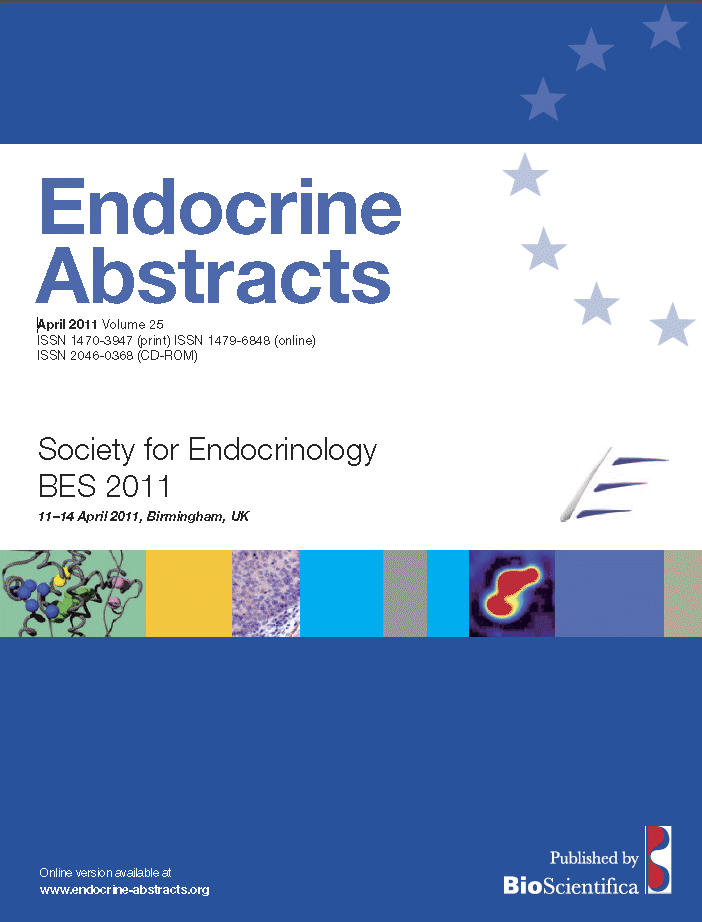Poster Presentations
Reproduction
ea0025p263 | Reproduction | SFEBES2011
Endocrine disruptors and their association with male reproductive disorders and testicular dysgenesis syndrome: establishing a xenografting model of human fetal testis development
Mitchell Rod , Saunders Philippa , Childs Andrew , Cassidy-Kojima Claire , Anderson Richard , Wallace Hamish , Kelnar Chris , Sharpe Richard
ea0025p264 | Reproduction | SFEBES2011
Distinct expression pattern of Dicer1 correlates with ovarian-derived steroid hormone receptors in human Fallopian tubes during the ovulatory process and in the mid-secretory phase.
ea0025p265 | Reproduction | SFEBES2011
The effect of atorvastatin on adrenal and ovarian hyperandrogenemia in patients with polycystic ovary syndrome.
Sathyapalan Thozhukat , Smith Karen A , Coady Anne-Marie , Kilpatrick Eric S , Atkin Stephen L
ea0025p267 | Reproduction | SFEBES2011
Placental iodothyronine deiodinase activity across the placental bed in normotensive (NT) and pre-eclamptic (PE) pregnancies.
Kurlak Lesia , Mistry Hiten , Kaptein Ellen , Visser Theo , Pipkin Fiona Broughton
ea0025p268 | Reproduction | SFEBES2011
In support of the ‘Rotterdam’ PCOS criteria: Identical LH responses to GnRH stimulation in women with oligo-/amenorrhoea and polycystic ovaries regardless of androgen status
Lewandowski Krzysztof , Cajdler-Luba Agata , Bienkiewicz Malgorzata , Lewinski Andrzej
ea0025p269 | Reproduction | SFEBES2011
Kisspeptin-54 injection stimulates activity of the human GnRH pulse generator in healthy women
Jayasena Channa N , Comninos Alexander N , Misra Shivani , Ali Abbara , Aniket Tavare , Donaldson Mandy , Ghatei Mohammad A , Bloom Stephen R , Dhillo Waljit S
ea0025p270 | Reproduction | SFEBES2011
Expression and functional activity of thyroid hormone transporters in microvillous plasma membranes from human term placental syncytiotrophoblasts
Loubiere Laurence , Vasilopoulou Elisavet , Franklyn Jayne , Kilby Mark , Chan Shiao
ea0025p271 | Reproduction | SFEBES2011
Increased epididymal Rnase9 expression in Rnase10 (−/−) mice
Sharp Victoria , Krutskikh Anton , Dacheux Jean-Louis , Poutanen Matti , Huhtaniemi Ilpo
ea0025p272 | Reproduction | SFEBES2011
Is age of vaginal opening an indicator of leptin sensitivity in female Sprague Dawley rats?
Sleeth Michelle , Beale Kylie , Thompson Emily , Baxter Jordan , Bloom Stephen , Murphy Kevin
ea0025p273 | Reproduction | SFEBES2011
A case of severe refractory hypercalcaemia in pregnancy caused by hypersecretion of parathyroid hormone related peptide (PTHrP) by the placenta.
ea0025p274 | Reproduction | SFEBES2011
Comparison of cardiovascular markers and variability of insulin resistance in women with anovulatory and ovulatory polycystic ovary syndrome
Cho Li Wei , Kilpatrick Eric , Keavil Brian , Jayagopal Vijay , Coady Anne Marie , Atkin Stephen
ea0025p275 | Reproduction | SFEBES2011
Male germ cell activity during perinatal reproductive development in the mouse
Jarvis Sheba , Winston Robert , Fraser Scott , Readhead Carol
ea0025p276 | Reproduction | SFEBES2011
Defining insulin signalling pathways in granulosa-lutein (GL) cells in women with polycystic ovary syndrome (PCOS)
Joharatnam Jalini , Lamanna Giuseppina , Trew Geoffrey , Lavery Stuart , Hardy Kate , Franks Stephen
ea0025p277 | Reproduction | SFEBES2011
Increased intensity of P450c17 protein expression in theca cells from polycystic ovaries
Comim Fabio , Hardy Kate , Franks Stephen
ea0025p278 | Reproduction | SFEBES2011
Neuromedin B stimulates the hypothalamo-pituitary–gonadal axis in male rats
Boughton Charlotte , Patel Sejal , Amin Anjali , Thompson Emily , Ghatei Mohammad , Bloom Stephen , Murphy Kevin
ea0025p279 | Reproduction | SFEBES2011
Nesfatin stimulates the hypothalamic–pituitary–gonadal axis in male rats
Patterson Michael , Wynne Katie , Patel Sejal , Suzuki Keisuke , Tadross John , Ghatei Mohammad , Bloom Stephen
ea0025p280 | Reproduction | SFEBES2011
Study of role of retinol-binding protein 4 in women with polycystic ovary syndrome
Eldieb Abdel-Sattar , Makboul Khalid , Abd El Baki Rania
ea0025p281 | Reproduction | SFEBES2011
HRPE773 (ZG16B) expression is elevated in human endometrium during the early secretory phase of the menstrual cycle and in uterine decidua following miscarriage
Ng Bonnie , McDonald Sarah , Ren Xia , Mullins John , Rae Michael , Critchley Hillary , Horne Andrew , Morley Steven
ea0025p282 | Reproduction | SFEBES2011
Case–control study of 5-alpha reductase type 2 Val89Leu polymorphism in Romanian PCOS patients
Radian Serban , Radulescu Cristina Ramona , Aflorei Daniela , Gheorghiu Monica , Baculescu Nicoleta , Albu Alice , Fica Simona , Grigorescu Florin , Coculescu Mihail




